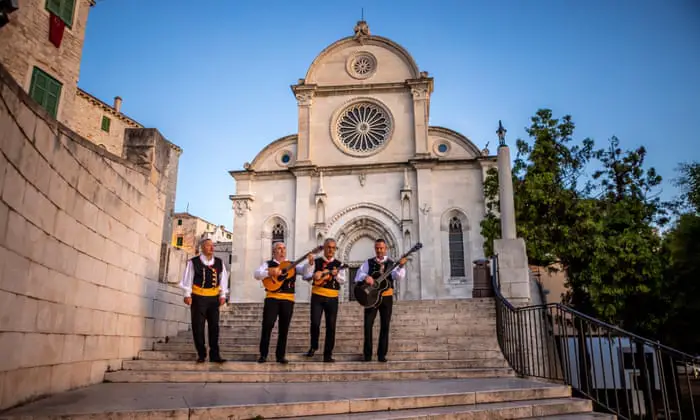
Croatia’s fabulous mishmash of cultures – from ancient Greeks to Romans, Venetians, Austrians, Hungarians and Italians – has left a rich legacy all around the country. You’ll see it in the Venetian architecture of Rovinj, Korčula, Dubrovnik and Hvar, the Habsburg townhouses of Zagreb and Opatija, and the ancient Roman ruins of Istria and Dalmatia. You’ll taste it in the delicious cuisine where the Adriatic and central Europe meet and mingle.
You’ll hear it when top-flight performers bring their magic to the Dubrovnik Summer Festival, the Split Summer Festival and the baroque music festivals of Korčula and Varaždin. Sultry Dalmatian summer nights echo to the sound of polyphonic klapa singers whose a cappella music makes the skin tingle. The klapa festival in the beautiful Dalmatian coastal town of Omiš every July is one of the summer’s unmissable events.
Croatia’s 10 Unesco world heritage sites – eight of which are cultural ones – give you a tantalising taste of the country’s heritage. Dubrovnik is the biggest draw, its pedestrianised old town a warren of marble alleyways, Renaissance and baroque palaces, and 14th-century monasteries – all ringed by magnificent medieval and Renaissance walls. Game of Thrones fans will immediately clock a few of the series’ locations – the Minčeta Tower on the city walls, the hulking 15th-century Fort Lovrijenac just outside the fortifications (where Shakespeare plays take place in the summer) and the broad sweep of the Jesuit Stairs, where the famous walk of shame scene took place in the series.
The elegant stone atrium of the 15th-century Rector’s Palace doubles as an atmospheric setting for classical concerts. Get a crash course in Dubrovnik’s past by visiting the Cultural History Museum. Just outside the walls is Lazareti, built in the 14th century as quarantine quarters but now the city’s cultural hub where you can watch folklore performances from the Linđo Folklore Ensemble.
Dubrovnik hosts spectacular festivals – starting off the year with a celebration of its patron saint in February’s Festival of St Blaise with processions, parades and feasting on the wonderfully rich and meaty šporki makaruli pasta. That gets everyone in the mood for the lively pre-Lent carnival later in the month. Once harvest season comes round, the Good Food Festival takes over Dubrovnik’s main thoroughfare, Stradun, in October with communal lunches and chefs’ workshops. One delicacy you won’t want to miss is the delicately sweet Ston oysters, which come from the village of Mali Ston on the nearby Pelješac peninsula.
Croatia’s second-largest city, Split, has one of the more unusual Roman relics, Diocletian’s Palace, built around the 3rd century AD and whose Unesco-listed ruins were colonised centuries ago and now squeeze in cafes, shops and restaurants among graceful columns, arches and vaulted cellars. Once you’ve strolled along the Riva waterfront, stopping for coffee on one of on the pleasant cafe terraces, head to Split’s western side to gaze at the wondrous art in the Meštrović Gallery, where the works of Croatia’s best-known sculptor Ivan Meštrović are displayed in his former summer palace, facing the sea.
Close to Split airport, the island town of Trogir is one of Croatia’s most captivating. Connected to the mainland by a bridge, its Unesco-listed old town has a wealth of well-preserved Romanesque, Renaissance and baroque architecture, much of it showing Venice’s stamp. There’s more Venetian splendour farther up the coast in Šibenik, one of the few Dalmatian cities founded solely by Croatians. So while there’s no sign of an ancient Greek or Roman settlement, you have the awe-inspiring sight of the gothic-Renaissance Cathedral of St James and its magnificent barrel-shaped roof. Walk up to the top of the town to the medieval St Michael’s Fortress for fantastic Adriatic views and, during summer months, concerts and plays in its open-air theatre.
Carry on northwards to Zadar for a vivid snapshot of Croatia’s history. All within the same square in Zadar’s old town, you can see ruins of the ancient Roman Forum, the Byzantine Church of St Donatus, the 12th-century Cathedral of St Anastasia and a Benedictine monastery founded in the 11th century.
Dangling off Croatia’s northernmost coast is heart-shaped Istria, where culture and cuisine come together in a winning combination. The Venetian coastal resorts of Rovinj and Poreč are breathtaking, with their enchanting old towns of narrow marble lanes and colourful townhouses set on their own little peninsulas. One of the world’s best-preserved Roman arenas, Pula amphitheatre was built between 27BC and AD68 and is the setting for outdoor concerts as well as screenings during the Pula Film Festival, which takes place in July.
While some of Croatia’s juiciest mussels and oysters are harvested within Istria’s Lim Channel, if you head inland to the medieval hilltop villages of Motovun, Buzet and Livade, you’ll find that truffles are the culinary star and celebrated at autumnal festivals. Combined with Istria’s award-winning olive oils and wineries, you have a true taste of Croatia.
Find out more by visiting croatia.hr






